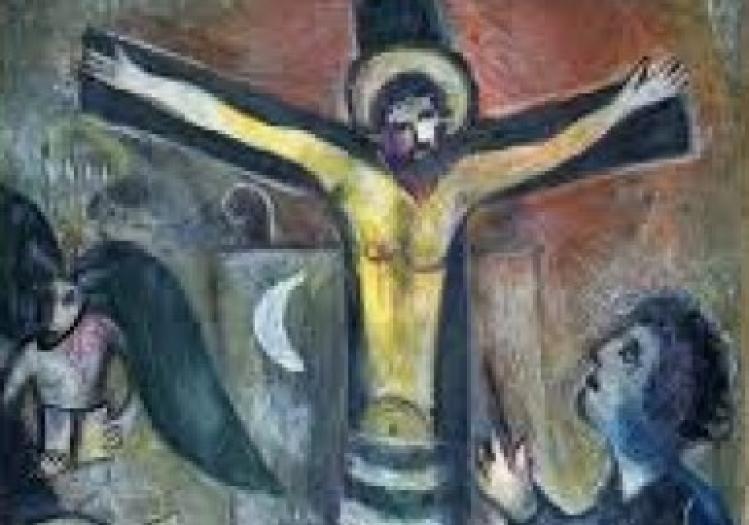
Jesus is Jewish. Is there a more basic fact about him than that? Nothing has altered our understanding of Jesus more than our relatively recent attention to his Jewishness.
Yet the actual image of a Jewish Jesus hanging on a Cross still gives pause to both Jews and Christians. Marc Chagall, the Russian-born son of a Hasidic family, painted many such images—many more than most have ever seen. More than twenty-five of them have been collected in “Chagall: Love, War, and Exile,” at New York’s Jewish Museum (through February 4, 2014; free app with commentary and some of the paintings available at iTunes store). Though Chagall first painted the image of Jesus on the Cross as a student in Paris in his 1912 piece Calvary, this exhibit focuses on the 1930s and ’40s, when Chagall lived in exile, first in France and then the United States.
During the war years, the Crucifixion became a focus of Chagall’s work. Standing before them, the viewer encounters a Jesus whose Jewishness is more than merely notional. Chagall places that fact at the center of these works. I’ve seen some of these paintings before: White Crucifixion at the Art Institute of Chicago and Calvary at New York’s Museum of Modern Art (see also “Mel Gibson Meets Marc Chagall,” Commonweal, February 2004). They seemed like curiosities: Why would a Jewish artist paint the Crucifixion? (When I was young I wondered whether Chagall became a Catholic, like his friend Raïssa Maritain. He did not.)
The sheer number of these paintings and the variety of settings in which Chagall locates the man on the Cross make this new exhibit more than a curiosity; it is an epiphany. Evoking the pogroms of pre-Revolutionary Russia, a crucified Jesus presides over Chagall’s native village as it burns. Two panels of a triptych depict Crucifixion scenes amid references to the 1917 Revolution and Russia’s resistance to Hitler. In some paintings, Jesus wears a loincloth patterned on the tallit (the Jewish prayer shawl) while a halo circles his head (a Christian symbol). Others have Mary and John at the foot of the Cross. In still others, mythical and mystical figures along with earthly ones float around the crucified Jesus: angels, animals, Torah scholars, bearded rabbis, Madonna and child, Joseph of Arimathea with a ladder, and the artist himself—upside down beside the Cross—all in the vibrant, saturated colors typical of Russian icons. Titles like The Martyr and Christ Carrying the Cross underline Chagall’s appropriation of Christian imagery.
Even more startling, the crucified Jesus dominates scenes from Hebrew Scripture. In one painting, the Jewish people cross the Red Sea under the gaze of a crucified Jesus; Moses, who is carrying the stone tablets, is relegated to the lower right corner of the canvas. If the Christian viewer is disconcerted by such an image, how does a Jewish viewer respond? What did Chagall intend?
While the Crucifixion was for centuries the source of anti-Judaism and Jewish persecution, Chagall saw Jesus as the quintessential Jewish martyr. The Cross represents his own suffering as well as that of the Jewish people. During the war years, as news of the death camps came to the United States, Chagall held out hope that images of the suffering Jesus would evoke a response in Christians. But, as he wrote, “with few exceptions, their hearts are silent.”
Chagall acknowledged the transgressive nature of combining images sacred to Jews and Christians. His fellow Jews, especially in the United States, criticized him. But he paid little attention. In words and images, he identified himself with the man on the Cross. In Christ and the Artist, he gazes up at the Cross with palette in hand. In another painting he substitutes his first name for the inscription “INRI” at the top of the Cross.
To Christians these beautiful paintings offer a salutary meditation. To some Jews they may remain an affront. The catalog strives to locate Chagall and his work in a specifically Jewish context: “the Crucifixion images were not—or not primarily—an expression of Christian theology,” it explains. “For him the Cross was a symbol of persecution and oppression rather than a sign of redemption and hope.” And yet, it is also a symbol reminding us that memory, not timeless myth, is at the heart of both Christian and Jewish faith.

